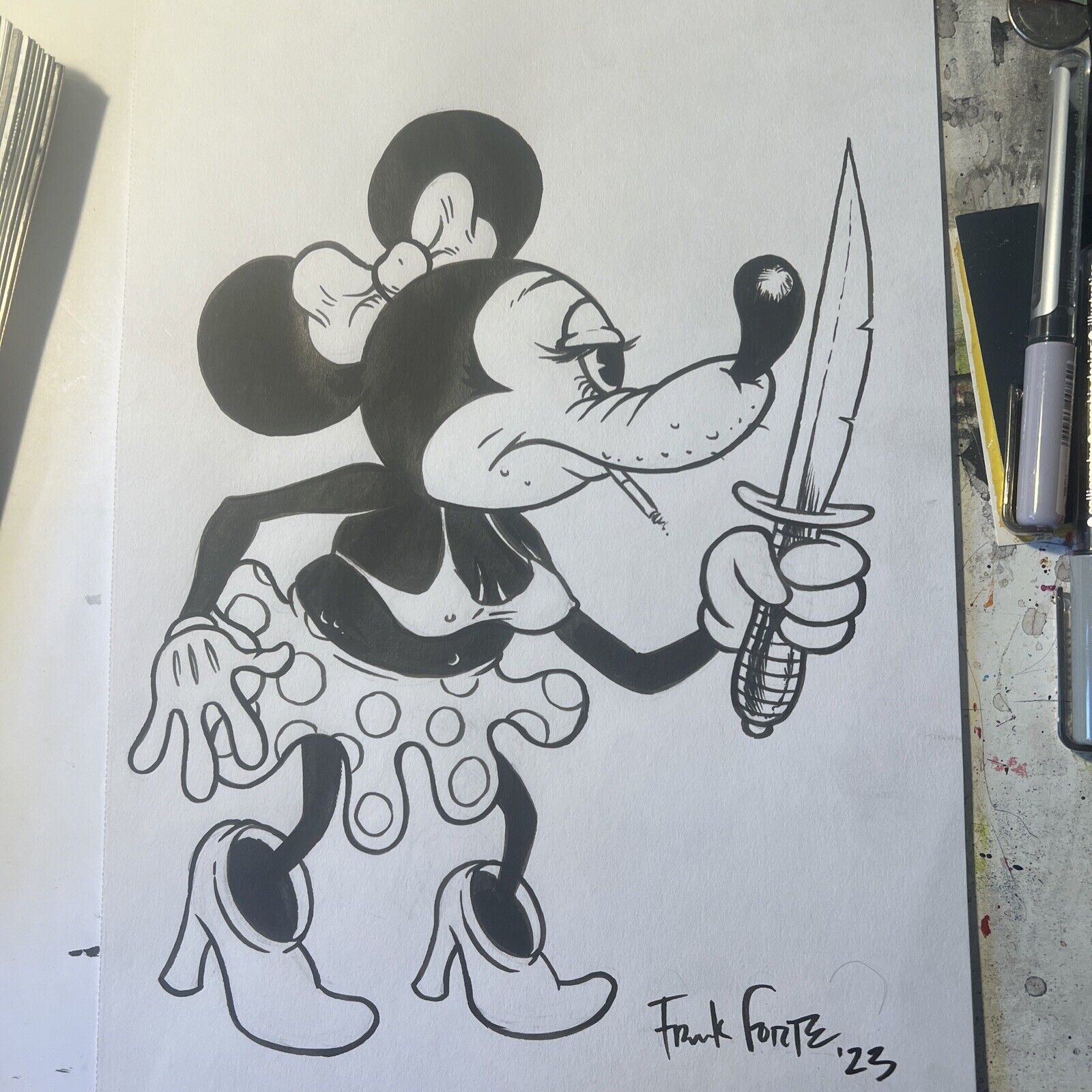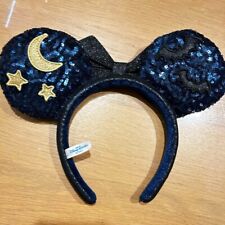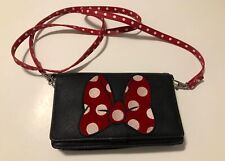Minnie Mouse With Cigarette Pop Surrealism Original Art drawing By Frank Forte For Sale

When you click on links to various merchants on this site and make a purchase, this can result in this site earning a commission. Affiliate programs and affiliations include, but are not limited to, the eBay Partner Network.
Minnie Mouse With Cigarette Pop Surrealism Original Art drawing By Frank Forte:
$100.00
Original Rubber Hose Minnie mouse with cigarette and knife, Pop Surrealism Art drawing By Frank Forte
comic art drawings By Frank Forte (Bob's Burgers, Solar Opposites, Heavy Metal) sketches.
Original Art Copic Marker Drawing using Copics, pencil, crayon, caran dache On 9 x 12 paper
Comes with COA CERTIFICATE OF AUTHENTICITY
Great Gift idea.
Frank Forte Bio
Frank Forte is an artist, writer, and storyboard artist. His work has been exhibited at La Luz De Jesus Gallery (LA, CA), COPRO GALLERY (SANTA MONICA, CA), CASS Contemporary (Tampa, FL), DARK ART EMPORIUM (LONG BEACH, CA), STAN LEE?S COMIC UNIVERSE (SHANGHAI, CHINA), Sally Centigrade Gallery (Denver, CO), Arch Enemy Arts (Philadelphia, PA), The Gabba Gallery (LA, CA), Dream Factory Art (Frankfurt, Germany), The Phone Booth Gallery (Long Beach, CA) Night Gallery Fine Arts, Cannibal Flower and the Los Angeles Municipal Art Gallery among others.
Frank?s film and TV credits include: SOLAR OPPOSITES, LOVECRAFT COUNTRY, Bob?s Burgers, 3 Below (Trollhunters spin-off), Truth or Dare, Insidious: The Last Key, Despicable Me 2, The Emoji Movie, LEGO Guardians of the Galaxy: The Thanos Threat, LEGO Star Wars: The Empire Strikes Out, The Super Hero Squad Show, Marvel Heroes 4D, and more. Frank is also the publisher of Asylum Press an indie graphic novel and comic book
publisher. Frank has written, illustrated and published such comics as; Bob's Burgers, Heavy Metal, The Vampire Verses, Warlash, Fearless Dawn, Billy Boy, The Cletus and Floyd Show.
Inspired by a steady diet of classic cartoons, comics and horror films, Frank Forte continues to explore the realm of disturbed characters that seem trapped in a nightmarish animated world. His most recent series of Neo-Pop paintings incorporate the reappropriation of figures and images we know from the yesteryear of the animated film, comic books, TV, advertising and pop culture as well as introducing Frank?s original characters.
Bob's Burgers is an American animated sitcom created by Loren Bouchard for the Fox Broadcasting Company. The series centers on the Belcher family ? parents Bob and Linda and their children Tina, Gene and Louise ? who run a hamburger restaurant. The show was conceived by Bouchard after he developed Home Movies. Bob's Burgers is a joint production by Wilo Productions, Buck & Millie Productions, and 20th Century Fox Television and syndicated by 20th Television.
BOB?S BURGERS, a 2018 Emmy Award nominee for Outstanding Animated Program, returns for a hearty ninth season on FOX. The series follows BOB (H. Jon Benjamin) and his ever-quirky family who together run the restaurant Bob?s Burgers.
?
In addition to its 2018 Emmy Award nomination for Outstanding Animated Program, the series has been nominated in the same category in 2014, 2015, 2016 and 2017, having won the award twice, its first Emmy Award in 2014 and in 2017. It was also Emmy-nominated in the category of Outstanding Character Voice-Over Performance (John Roberts) in 2015. Also in 2017, BOB?S BURGERS was nominated for a 2017 Critics? Choice Award for Best Animation Series, and won two Annie Awards, one for Best General Audience Animated Television/Broadcast Production and the other for Outstanding Achievement for Writing in an Animated TV/Broadcast Production.
?
This fall, BOB?S BURGERS will air in an all-new time period on Sunday, from 8:30-9:00 PM ET/PT. The series will celebrate its milestone 150th episode, which also is the Season Nine premiere episode, ?Just One of the Boyz 4 Now for Now.? In the special musical episode, featuring four original songs, Tina (Dan Mintz) hunts down her ?soulmate? at replacement auditions for her favorite boy band. The upcoming season also will feature its annual holiday-themed episodes and all-new and returning guest voices, including Josh Gad, Andrew Rannells and Daveed Diggs.
BOB?S BURGERS is a 20th Century Fox Television and Bento Box Entertainment production. The series was created by Loren Bouchard. Bouchard and Jim Dauterive serve as executive producers and writers.
The series premiere, "Human Flesh", drew in 9.39 million viewers, making it the highest-rated series premiere of the season and finishing ninth in the ratings for the week it aired. Reruns began airing on Cartoon Network's late night programming block Adult Swim in 2013 and its sister channel TBS in 2016. and began airing in syndication on local stations in September 2015.
A comic book series based on the show, published by Dynamite Entertainment, began in September 2014 and a soundtrack album was released on May 12, 2017.
In 2013, TV Guide ranked Bob's Burgers as one of the top 60 Greatest TV Cartoons of All Time. The series has been nominated for several awards, including the Emmy Award for Outstanding Animated Program seven consecutive times, winning in 2014 and 2017.
The show has run for nine seasons and has been renewed by Fox for a tenth season on Animation Domination.[8] A feature film of the animated television series is in the works and is scheduled for a July 17, 2020 release.
?
Lowbrow, or lowbrow art, describes an underground visual art movement that arose in the Los Angeles, California area in the late 1960s.[1] It is a populist art movement with its cultural roots in underground comix, punk music, tiki culture, graffiti, and hot-rod cultures of the street.[2] It is also often known by the name pop surrealism.[3] Lowbrow art often has a sense of humor ? sometimes the humor is gleeful, sometimes impish, and sometimes it is a sarcastic comment.[4]
Most lowbrow artworks are paintings, but there are also toys, digital art, and sculpture.
Some of the first artists to create what came to be known as lowbrow art were underground cartoonists like Robert Williams and Gary Panter. Early shows were in alternative galleries in New York and Los Angeles such as Psychedelic Solutions Gallery in Greenwich Village, New York City which was run by Jacaeber Kastor,[5] La Luz de Jesus run by Billy Shire[6] and 01 gallery in Hollywood, run by John Pochna.[5] The movement steadily grew from its beginning, with hundreds of artists adopting this style. As the number of artists grew, so did the number of galleries showing Lowbrow. In 1992 Greg Escalante helped orchestrate the first formal gallery exhibition to take low brow art seriously; painter Anthony Ausgang?s solo show "Looney Virtues? at the Julie Rico Gallery in Santa Monica. The Bess Cutler Gallery also went on to show important artists and helped expand the kind of art that was classified as Lowbrow. The lowbrow magazine Juxtapoz, launched in 1994 by Robert Williams, Greg Escalante, and Eric Swenson, has been a mainstay of writing on lowbrow art and has helped shape and expand the movement.[7]
Writers have noted that there are now distinctions to be drawn between how lowbrow manifests itself in different regions and places. Some see a distinct U.S. "west coast" lowbrow style, which is more heavily influenced by tiki, underground comix and hot rod car-culture than elsewhere. As the lowbrow style has spread around the world, it has been intermingled with the tendencies in the visual arts of those places in which it has established itself. As lowbrow develops, there may be a branching (as there was with previous art movements) into different strands and even whole new art movements.
In an article in the February 2006 issue of his magazine Juxtapoz, Robert Williams took credit for originating the term "lowbrow art." He stated that in 1979 Gilbert Shelton of the publisher Rip Off Press decided to produce a book featuring Willams' paintings. Williams said he decided to give the book the self-deprecating title The Lowbrow Art of Robt. Williams, since no authorized art institution would recognize his type of art. "Lowbrow" was thus used by Williams in opposition to "highbrow." He said the name then stuck, even though he feels it is inappropriate. Williams refers to the movement as "cartoon-tainted abstract surrealism."[8] Lately, Williams has begun referring to his own work as "Conceptual Realism."[9]
?
POP SURREALISM
Highly polished imagery inspired by cartoon characters and scenery ? that is how one could describe Lowbrow art, also known as Pop Surrealism, but the truth is that this unconventional movement is much more than that. Are we even entitled to calling it a movement? Many acclaimed critics and respectable institutions, put in charge to decide what gets to be accepted as art and what does not fit in the mainstream demand of museums, galleries and even collectors, would put Lowbrow in the latter category without thinking twice. But like many movements before it, Lowbrow art does not care about being recognized by the art world as legitimate; if anything, Lowbrow artists wrote their own rules in an unapologetic way, rules that were clear enough to make this whole creative field stand on its own without a single problem. Because of its roots in the underground culture, Lowbrow / Pop Surrealism became a populist matter, inspired by such vast variety of topics and aesthetics that it made itself easily relatable to a large number of artists and admirers. So what exactly is it that makes Lowbrow art so distinct and alluring?
The Advent of Lowbrow Art
Born in the shady corners of Los Angeles in the late 1970s, Lowbrow originated in the artworks of underground cartoonists that were put on display in alternative galleries in New York and California. Because of their particular artistic approach, they weren?t perceived as ?highbrow? or intellectual art ? mainly because they were based on the rawness of underground comix, the rebellion of punk music, the hot rod and surf culture of the West Coast and, of course, stylized cartoons and comics. In fact, it would seem as though Its Highness the art world was not particularly fond of this Lowbrow kind of humor, one that can be found in John Waters movies, or Acid house flyers, circus posters, kitsch art, Kustom Kulture, Japanese anime, second-rate horror movies, psychedelic art pieces and even graffiti and street art. As a consequence, Lowbrow art and its self-taught practitioners joined the club of the ?outlaws? like illustrators, tattoo artists and comic book artists, and enjoyed its own status of an academically neglected movement which nevertheless thrived in a self-made environment. As such, Lowbrow art also managed to find home in many places around the globe and reflect their visual tendencies, thus evolving into many different branches and individual aesthetics.
Cartoon-Tainted Abstract Surrealism
Although it did not have an official name until the beginning of the 1990s, Lowbrow art was already somewhat present in popular culture during the 1960s too, as its traces could be found in the works of underground comix cartoonists like R. Crumb, S. Clay Wilson, Victor Moscoso and Robert Williams. Ever since its earliest days, Lowbrow was dedicated to poking fun at the conventional matters of any kind, using humor and sarcasm as its strongest tools. Persistent in vision, Lowbrow created its own subversive culture filled with abstract imagery and dreamy cartoon characters painted and drawn with impressive technical ability ? one that surely did not deserve to be ignored. The accomplishments of Lowbrow / Pop Surrealism creatives was firmly recognized, however, by the Juxtapoz magazine, founded in 1994 by the aforementioned Robert Williams. A pioneer and the biggest figure of the movement, he claims to have coined the term ?lowbrow? and there is nobody to dispute that, as the support that his magazine has given to the artists and the production at large is still immense and important. Juxtapoz magazine gave these artworks visibility, popularity and a background in writing that was somewhat critical, and it freed this form of art from under the ?dictatorship? of the New York scene and its predisposed rules of what art should mean and look like.
Lowbrow Goes Pop Surrealism
Following the rise of Juxtapoz Magazine, as well as another seminal publication called Hi-Fructose, a number of individuals within the Lowbrow art movement began breaking away from the raw, gritty representation of cartoons and counterculture. Putting their classical artistic training to use, they started creating their artwork with more sophistication; the goal was to produce a ?more beautiful? imagery, while at the same time not abandoning the core of Lowbrow ? its underground references. Despite their master painter techniques, these creatives did not reach the realms of the ?snobbish? Highbrow ? nor was this their intention ? but they nevertheless managed to blur the line between low and high art, giving way to a new subclass of pieces that could be defined as Pop Surrealism. The invention of the term was attributed to artist Kenny Scharf, who used it to describe his own paintings, an unlikely, yet rather successful mix of Pop art and Surrealism.

Related Items:
Disney Minnie Mouse Headband Midnight Ears Halloween Tokyo Disneyland 2023
$37.99
Shanghai Disneyland Disney Minnie Mouse Headband Heart Donald Daisy Duck
$29.99
Disney Parks Minnie Mouse Bow Smart Cell Phone Purse Credit Card Holder
$12.22



